As an Amazon Associate I earn from qualifying purchases.
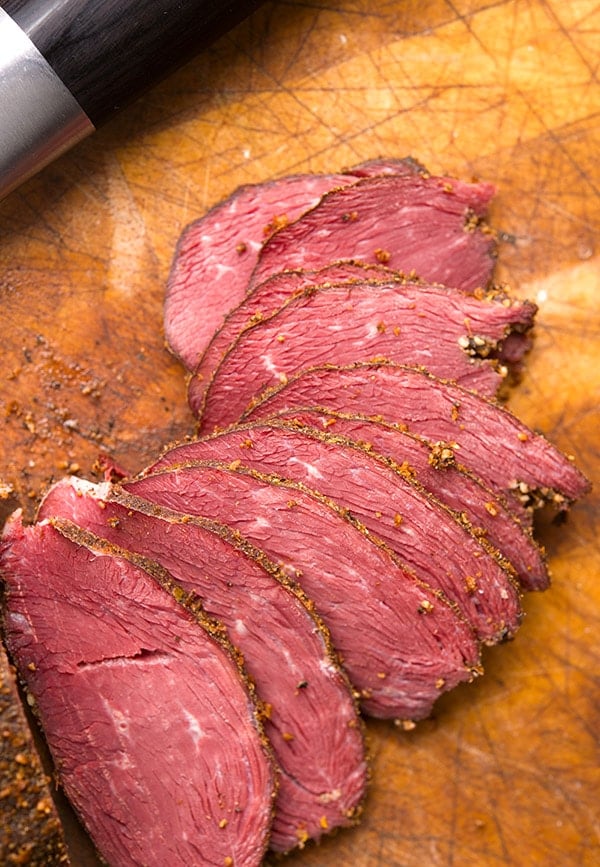
Goose pastrami is what I do with most of my Canada goose breasts. It is an easy project that makes the most out of these often-tough slabs of meat.
Why geese? Well, Canada and snow geese are very close to grass-fed beef in flavor (they eat the same thing), they have large, easy-to-work-with breasts, and they do have a tendency to be tough, which means that any way you can cook them that lets you slice the breasts thinly is a good thing.
Pastrami, in case you’ve never had it, is a cured meat from Eastern Europe or Turkey — remember the Ottomans ran Eastern Europe for a while — that’s normally beef or mutton. Although here’s an interesting tidbit from Wikipedia: “Among Jewish Romanians, goose breasts were commonly made into pastrami because they were inexpensive.”
So there ya go. This is traditional!
To make pastrami, you dry cure (sometimes brine) the meat for a few days, dry it a bit, coat it in the characteristic black pepper and coriander and then smoke it. Sliced thin on a sandwich, it’s God’s gift. Good pastrami at a Jewish deli is something you must eat at least once before you die.
If you have any goose breasts in your freezer, go for it. A pastrami on rye with good mustard, a slice of cheese and maybe some sauerkraut, and you got yourself some awesome there!
Once you make your pastrami, it will need to be eaten within a week or two, or you’ll need to vacuum seal and freeze it.\
Goose Pastrami
Ingredients
- 2 skinless Canada goose (or domestic goose breasts
- Kosher salt see recipe notes
- 3 grams Instacure No. 1, good for up to 3 pounds of goose
- 1/2 teaspoon dried thyme
- 1/4 teaspoon celery seed
- 1/4 teaspoon caraway seed
- 1 teaspoon sugar
- 1/4 teaspoon crushed juniper optional
- 1 teaspoon ground black pepper plus 1 tablespoon ground black pepper
- 1/4 cup brandy red wine, vinegar or water
- 1 tablespoon ground coriander
Instructions
- Weigh your goose breasts. For every pound of goose, you'll need 10 grams of kosher salt, which is about a tablespoon. It's OK if you are a little off on this measurement. Mix the salt, curing salt, sugar as well as the thyme, celery seed, caraway, juniper and the teaspoon of black pepper and grind them all together in a spice grinder. Pack the goose breasts with this mixture, massaging it into the meat. Put the goose into a closed container in the fridge for 24 to 72 hours.
- When you are ready, rinse off the goose and pat it dry. It's fine if you have a little bit of the cure stuck to the meat, but you don't want too much. Put the goose breasts on a rack in the fridge and let them dry uncovered for a day.
- Dip the goose into the brandy -- or really any other liquid you want -- and then coat thoroughly in the remaining black pepper and ground coriander seed. I like to grind this myself so the texture is a little coarse, a little fine.
- Smoke the goose breasts until the interior hits 140°F, which takes me about 3 hours.
- Let the goose pastrami cool and eat as lunch meat, or on crackers or whatever.
Notes
Nutrition
Nutrition information is automatically calculated, so should only be used as an approximation.
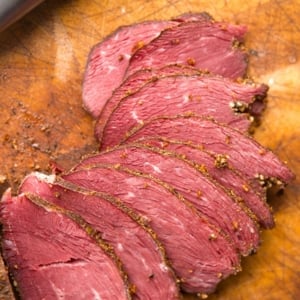
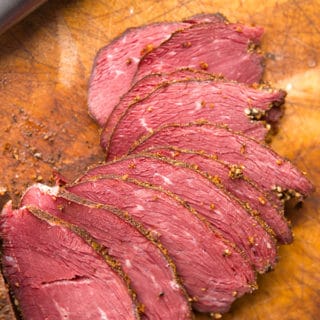

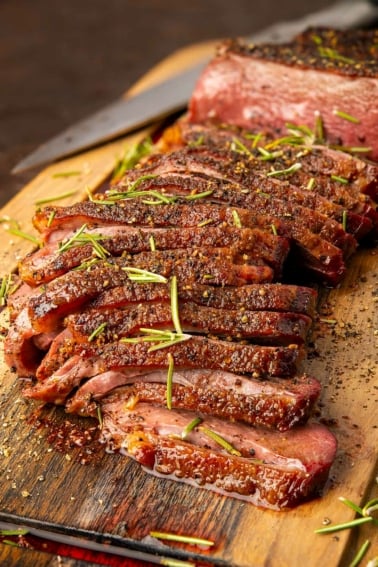
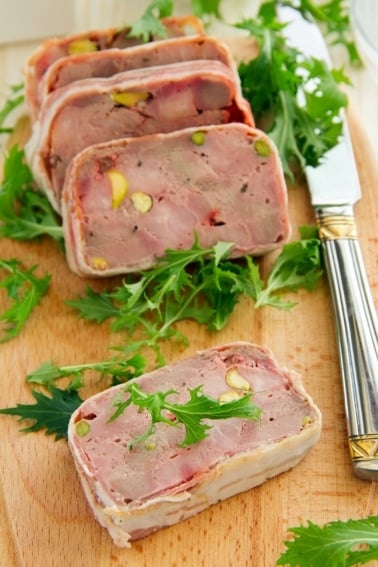

Took the breasts out of Two Geese that I had killed the weekend before christmas and prepared them for Pastrami. The family loved it!!! Even my mother in law ate it!
Hank,
If a man doesn’t have a smoker (a crime, I know), what do you suggest for temp and time in the oven for this recipe? I assume you’d want to still keep it low and slow.
Thanks! Love your recipes!
Do you think this recipe would work with pheasant? Looking for something different with the upland gamey bird. Would have to adjust due to the smaller breasts of the pheasant.
Mark: I would not do it with pheasant.
Outstanding! I was a confit addict now I’m a pastrami addict. Not salty, easy to prepare and it freezes well. Thanks Hank.
Hey Hank – I’ve seen a few other recipes for goose pastrami. Some of them call for brining the goose using tenderquick and a sugar/salt mixture anywhere from 10-14 days. That seems excessively long to me. What are your thoughts on the tenderquick and length of brining?
Kent: That’s insane. Way too long. A Canada goose breast, even skin on, won’t take more than 48 hours to fully cure.
My brother and I made this to break out from our grinding sausage routine. It was fantastic and relatively easy (even for idiots on the first try). We smoked the breasts longer at 120 degrees for ten hours and it really made a fantastic addition to the charcuterie plate A great learning experience. Thanks Hank.
Can’t wait to try this. Thanks
This stuff is nothing short of amazing
We take a lot of Canada geese every season and this is our go to recipe.
Best. Pastrami. Ever.
Just a couple of remarks to help those who go to make this. I’m in the smoking phase of my second batch.
First, sourcing whole corriander seeds was troublesome. I could not find any in the spice sections of any of my local grocers. I have hard the bulk food section at Whole Foods has them. I bought a ship load sized bag online.
Second, I use the chopper,grinder, mincer attachment for my stick blender to grind the peppercorns and corriander seeds. I find putting the peppercorns in first and doing a demi-grind on them and then adding the corriander seeds makes for a more uniform consistence of the resulting mixture. The peppercorns are harder and don’t grind at the same rate as the corriander seeds.
First time and it was better than expected, great addition to my game dinner menu
Awesome Hank! Here is a link to the great online calculator I use.
https://www.diggingdogfarm.com/page2.html
I have been tweaking this recipe for years now and for me the Ideal salt level is 1.75% and 156 ppm nitrite. Just remember the weight you enter on the first line is the weight of your meat AND water combined.
Hope that helps.
I could add to your list of HAGCactivities, fun of making exquisite furniture. from exotic local ewoods. try it. in the meanime, i heartily enjoy your blog stories, and truly wish i could join you on your hog hunt.
an old grouse hunter from Hebe, PA
Chad, I always do this recipe skin on. The skin adds a beautiful hit of fatty flavor. We are lucky enough to have some pretty fat canadas around where I live.
Hank, You are my Guru! Rock on! Question – Have you ever tried equilibrium brining? Once I discovered it I never used any other method. Id love to see a blog post from you about it.
Kurtis: I need to do more of it. And when I get it down, I will post on EQ curing. It is excellent!
I would like to thank you for this recipe, It’s the best thing to do to a goose I’ve tried, and I’ve tried a lot.
So far I’ve processed about 50 geese and gave a lot away to the guys I hunt with.Everyone thats tried it has been happy with the results. I fiddle with the spices , depending on what I have on hand, and how I think it would improve the final result, but it’s all good. Big thumbs up!
Would my domesticated duck breasts be big enough? I’ve got too many drakes and it’s time for a cull. They’re pekin/rouen crosses, about 9 months of age.
Becky: Sure, they’ll work.
This is pretty much the only recipe I use for goose breasts. Using cherry to smoke has resulted in exactly what I wanted it to taste like while leaving the rest of the recipe as is.
I’ve turned a number of people who “hate” goose!
I’m really looking forward to trying this one!
Ever tried skin-on Canada goose breasts for this? I had a bunch of geese to process and the breasts were so pristine and fat, I couldn’t bring myself to skin them….
Thanks Hank. While my coffee grinder would work as a spice grinder, I’m not sure how the coffee would taste the next morning. I plan to chop up the peppercorns and coriander seeds using the mini-chopper attachment that came with the stick blender. It’s what I used to blend up the cure. Wonderful caraway seed aroma emanated when I took the lid off. Also, does it make any sense to try and toast the peppercorns and coriander seeds in a hot skillet, to release the oils, before grinding?